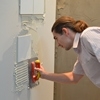The degree of surface sliding is determined by the kinetic and dynamic conditions of motion of the body interacting with the surface. When it comes to flooring, it is obvious how the degree of slip is related to the safety of using the surface. Today, this property of tiles is becoming increasingly important, partly due to laws and requirements that establish owner liability for accidents and injuries due to falling floors.
Friction coefficient is a parameter characterizing the degree of surface sliding. It is proportional to the force parallel to the interaction surface that must be applied in order to create relative motion between two bodies. This force also determines the conditions of equilibrium. The coefficient of friction depends on the nature of the two interacting bodies and on the conditions of the interaction itself, in particular, the state of the surface, the presence or absence of material between the surfaces, humidity, temperature, etc.
As for the nature of the surface, the coefficient of friction for floor surfaces (interacting with shoe soles) is lower, the higher the surface characteristics such as smoothness, shine, and ability to retain shape. That is, the higher the perforation resistance, the greater the likelihood of covering the surface with a thin, continuous layer of water, etc. The coefficient of friction is reduced on surfaces where there is oil, grease, dirt, water and other materials that act as a lubricant between the sole and the floor. Such materials create a slippery surface and increase the risk of falls and accidents.
Rough, uneven surfaces tend to have a higher degree of friction. The surface can be this way naturally, or this effect can be achieved with an appropriate relief of various shapes and sizes. These types of surfaces maintain a high level of coefficient of friction even when water or other liquids accumulate on them, since the uneven surface prevents the formation of a continuous layer of liquid, which reduces the coefficient of friction. It should be emphasized that surfaces that have a high degree of slip resistance are difficult to clean. This factor must be taken into account when choosing tiles.
Ceramic tiles, especially unglazed ceramic tiles, are generally the least slippery finishing material among floor coverings. There are several methods for testing tiles to determine the degree of sliding (coefficient of friction): BCRA method; ASTM Method C1028; method DIN 51130; method DIN 51097. Based on these methods, the standard EN ISO 10545-17 Determination of the coefficient of friction was developed.
BCRA method
The BCRA method is a method for instrumental determination of the dynamic coefficient of friction (μ, DCOF - dynamic coefficient of friction). The standards set out clear requirements that a tile surface must meet to be considered slip-resistant (μ must be ≥ 0.40 both when tested with a leather element, which simulates sliding on a dry tile surface, and in the case of a hard element test). rubber, which simulates sliding on a wet surface).
Dynamic friction coefficient:
- μ ≤ 0.19 dangerous slip level;
- 0.20 ≤ μ ≤ 0.39 excessive slip level;
- 0.40 ≤ μ ≤ 0.74 satisfactory coefficient of friction;
- μ ≥ 0.75 excellent friction coefficient.
Detailed description of the BCRA method.
ASTM Method C1028
Developed in the USA, the ASTM method allows, using appropriate equipment, the measurement of the static coefficient of friction (SCOF) between the test surface and a rubber sliding element loaded up to 50 pounds (222.7 N, approx. 23 kg). The static coefficient of friction is the ratio of the horizontal component of the force applied to a body that begins to slide, overcoming friction, to the pressure force that presses the rubbing bodies against each other. As in the case of dynamic friction, we are talking about a ratio of forces, therefore a value without specifying a unit of measurement.
Static friction coefficient:
- SCOF ≤ 0.50 dangerous slip level;
- 0.50 < SCOF < 0.60 satisfactory coefficient of friction;
- SCOF > 0.60 non-slip surface.
Detailed description of ASTM C1028 method.
Method DIN 51130
Floors in industrial premises or work areas where there is a high risk of slipping (for example, where substances such as fats, oils, water, food residues, powders, flour, vegetable waste often fall on the floor) are classified into the following groups:
- R9 - living rooms, factory and home canteens, restaurants, etc.; outpatient clinics, day hospitals, pharmacies, laboratories; hairdressers; laundries and dry cleaners; recreation rooms and classrooms in schools and kindergartens, etc.
- R10 - cellars; open air shopping areas; warehouses for storing packaged food products; open warehouses; covered and underground garages; open parking lots; kitchens in kindergartens and schools; workshops or workshops that use manual labor; outdoor recreation areas; factory gates, etc.
- R11 - premises for the production, storage and packaging of cheeses; rooms for processing raw materials; premises in which drinks are bottled or in which fruit juices are produced; kitchens of restaurants with up to 100 visitors per day; meat processing premises; flower shops; open air shopping areas; dyehouses; open warehouses; open parking lots; covered and underground garages into which precipitation penetrates; outdoor recreation areas; factory gates, etc.
- R12 - premises in which the production and packaging of margarine and other edible fats is carried out; premises where vegetable oil is bottled; premises where fresh milk and butter are processed; premises in which fats or liquid substances are processed; fire service parking lots; open loading and unloading platforms; gas stations of enterprises, etc.
- R13 - enterprises for refining edible vegetable oil (with V6); fat processing plants (with V4); slaughterhouses (with V10); sausage shops (with V8); fish processing shops (with V10); workshops for the production of canned vegetables (with V6), etc.
This method also involves measuring the so-called “accumulative space” V, which is the volume of depressions on the surface of tiles with an uneven texture. Water or other slip-causing products enter the grooves, leaving the surface in contact with the shoe's sole to be slip-resistant. During the measurement process, the mass of a substance with a known density required to completely fill the depressions on the front surface of the tile is determined. Classification is carried out depending on the volume per unit surface.
The value of the measured volume of the depressions [cm 3 /dm 2 ] – assessment group: 4 - V4; 6 - V6; 8 - V8; 10 - V10. Detailed description of the DIN 51130 method.
Method DIN 51097
In rooms where the floors are often wet and where people walk on them with bare feet (for example, the sides of swimming pools, children's pools, common shower rooms, saunas, etc.), the classification contains groups: A; B (A+B); C (A+B+C). Detailed description of the DIN 51097 method.
| The attachment | Size |
|---|---|
| 1.26 MB |
There are 3 Comments
Methods DIN 51130 and DIN 51097
Without going into technical details, let us clarify that knowledge of surface properties is extremely important for the cladding designer, tiler, end user and safety inspector. All of the above methods determine how slippery a surface is by its ability to resist slipping, that is, by its friction index, understood as the force opposing the movement of one body on the surface of another. They are distinguished: static friction - a force that counteracts the movement of a body that begins to move from a stationary (static) position, and dynamic friction - a force that counteracts the movement of an already moving body. As a rule, under equal accompanying conditions, dynamic friction is lower than static friction.
The DIN 51130 and DIN 51097 methods, also called "incline plane methods", consist of a person walking back and forth on a platform covered with the tiles being tested. The inclination of the test section increases at a constant rate until an angle is reached at which the person begins to feel unsure when walking, that is, begins to slide.
Classification DIN 51130. Accessory group - medium inclination angle:
- NC - (α < 6°);
- R9 - (6° ≤ α ≤ 10°);
- R10 - (10° < α ≤ 19°);
- R11 - (19° < α ≤ 27°);
- R12 - (27° < α ≤ 35°);
- R13 - (35° < α).
Classification DIN 51097. Accessory group - medium inclination angle:
- A - (12° ≤ α < 18°);
- B [A+B] - (18° ≤ α < 24°);
- C [A+B+C] - (α > 24°).
- Login to leave comments
Today the situation is like this
Regarding slip resistance, you just need to clarify the test method used (there are: German methods for determining the coefficient of friction in accordance with DIN51130 and classification A, B, C in accordance with DIN51097; American method for determining the static coefficient of friction in accordance with ASTM C1028; English method for determining the dynamic coefficient of friction - now used almost exclusively in Italy - in accordance with BCR TORTUS, etc.)
- Login to leave comments
Device BOT-3000E
BOT-3000E device is designed to determine the static and dynamic coefficient of friction of a wet (wet) or dry surface. The measurement is carried out using a series of test plates made of Neolithic, SBR, Four S, TRL, leather. Used by the Ceramics Center in Bologna.
Technical characteristics of the device
- scale (SCOF, DCOF): 0.00-1.00 μ;
- speed (DCOF): 20 cm/sec. ± 5%;
- Plates available: Neolithic, SBR, Four S, TRL, leather.
- Login to leave comments



